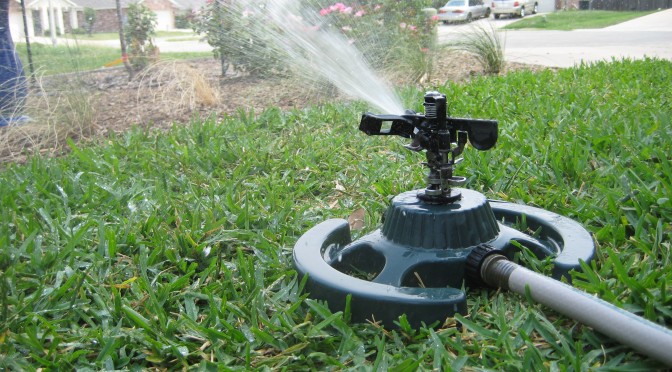Just as important as choosing the right plants for your yard, is choosing the right type of turfgrass. The main choices available to homeowners in the southern U.S. area are St Augustine, Bermuda, Buffalo, and Zoysia grasses. Each type has both positive and negative characteristics, and many varieties to choose from.
When planning your home landscape design, turfgrass of some type will probably make up at least some portion of your yard. One of the fastest ways to immediately make your yard look better, control soil erosion, keep your soil from turning into mud or dust, and controlling weeds is to properly install new turfgrass from sod. Although several types of turfgrass can be installed as seed, by choosing sod, you’ve let the sod grower do the hardest and most important task of establishing the turfgrass.
Turfgrass Characteristics
The main characteristics that we will look at for each type of turfgrass are shade tolerance, water requirement, traffic tolerance, fertilization requirement, mowing frequency, disease potential, and drought tolerance. By choosing the type of turfgrass that best matches your specific needs, you can ensure the most attractive and healthy lawn possible.
St Augustine
St Augustine is a course textured grass that has high shade tolerance, medium water requirements, low tolerance for traffic, requires a medium amount of fertilization, requires mowing every five to seven days, has high disease potential, and drought tolerance. St. Augustine grass is installed as sod in our area.
Bermuda Grass
Bermuda grass is a dense, fine textured turfgrass that has very low shade tolerance, has a medium to low watering requirement, high traffic tolerance, requires a high amount of fertilization, requires mowing every three to seven days, has medium to low disease potential, and very good to excellent drought tolerance. Bermuda grass can be installed as sod, plugs, or seed.
Buffalo grass
Buffalo grass is a fine textured turfgrass that has medium shade tolerance, has a very low watering requirement, medium traffic tolerance, requires a low amount of fertilization, requires mowing every seven to fourteen days, has low disease potential, and excellent drought tolerance. Buffalo grass can be installed as sod, plugs, or seed.
Zoysia
Zoysia is a medium textured grass that has medium to high shade tolerance, medium water requirements, high tolerance for traffic, requires a medium to low amount of fertilization, requires mowing every seven to ten days, has medium to low disease potential, and very good drought tolerance. Zoysia grass can be installed as sod, plugs, or seed.
How Much
Choose the turfgrass variety that best meets your needs, fits your landscape plan and your budget, is appropriate for the amount of sun and shade available in your yard, and looks best to you. Once you’ve chosen the type of turfgrass, you will need to determine how much you will need by calculating the size of the area to be covered in square feet. Pull out that old high school geometry book, get out in your yard with a tape measure and just break down the area to be covered into a series of squares, rectangles, and triangles, then add the areas together. Sod is typically sold by the pallet, which will cover 450 square feet. If choosing seed, check the bag to see how square feet it will cover. Divide your total square feet to be covered by 450 for sod, or by the coverage amount per bag of seed, and you will know how many pallets of sod, or bags of seed you will need.
Preliminary Steps
Before hopping in your car to rush out and pick up a few pallets of sod, there are several preliminary steps you should take. First off, although you can probably pick up your own seed in your car, sod will need to be delivered. A pallet of sod is big, it weighs a lot, and it would have a decidedly negative effect on your family vehicle. Call several local sod vendors to check their prices, availability, and how much advance notice they will need from the time you place your order until it can be delivered.
Whether installing sod, seed, or mulched beds, you will need to remove all of the dead grass, weeds, and rocks from your yard. Rototill your soil to a depth of four inches, being careful not to injure any tree roots, and establish the final grade. You may want to submit a soil sample to the Texas AgriLife Extension office for analysis. This will give you a detailed analysis of the types and amounts of soil amendments your soil may need.
Installation
Install mulched beds and pathways prior to installing your sod or seed. You can plant flowers and shrubs in the beds at any time. Lightly rake your soil just prior to installing your sod or seed. Spread seed evenly at the spreader setting recommended by the seed vendor. For sod, lay it in straight lines, starting along a driveway or sidewalk, and stagger the seams. Cut any odd size pieces need to fill in the gaps.
Care
Immediately water your seed or sod once installed, and every day until the roots are established when you see the grass start to grow. Once established, water every two to three days in the early morning hours, local restrictions permitting, moistening the soil to a depth of three to four inches. Mow your lawn with a sharp mower blade, often enough so that no more than one-third of the leaf blade is removed at any one time.
Now grab a cold drink and a chair on the front porch and enjoy your handy work. Remember, when designing and installing your home landscape, just take it one piece at a time, get help when needed, and have fun.


